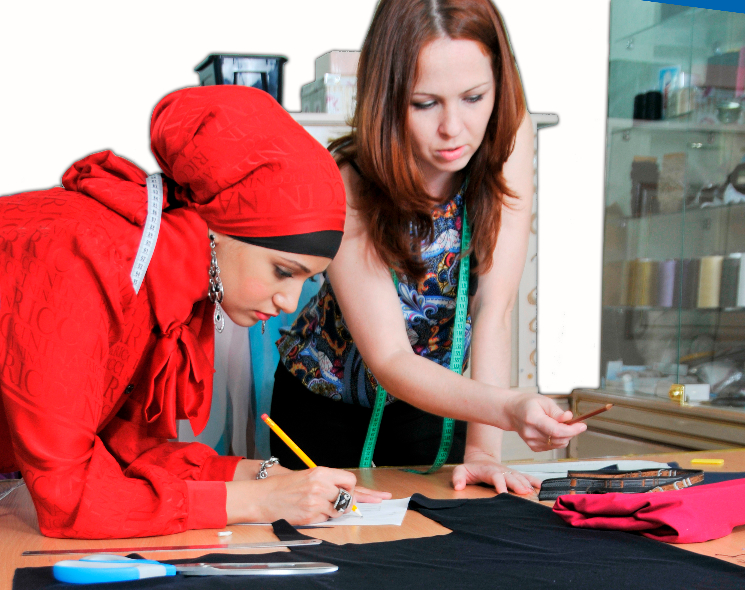Q&A-Russia’s modest fashion pioneer Sahera Rahmani talks quality-commercial success balance amid economic challenges
Photo: Russian modest fashion designer Sahera Rahmani (left) working in her studio / Courtesy Sahera Rahmani
Muslims make up approximately 10 percent of the 140 million population in the Russian Federation, with an estimated 1.5 million living in the capital city. Until only a few years ago, Moscow’s (Islamic) modest fashion market was confined to imported collections of Turkish and Arabic designers and a limited offer by local brands.
In 2012, Iranian-born Muscovite designer Sahera Rahmani emerged as a pioneer in Russia’s high-end modest fashion sector when she opened her first studio.
Her rise was quick and within four years Rahmani had gained brand recognition all over Russia and in the Commonwealth of Independent States. When Russia’s economy was hit by low oil prices and purses started shrinking from the second half of 2014, Rahmani responded by introducing collections for the mid-price range and developing new sales channels targeting a wider base beyond the Muslim community.
In this Q&A, Rahmani shares her business journey with regards balancing creativity, keeping a strong “brand DNA”, not compromising on quality, and developing commercial success in Russia’s emerging modest fashion sector in the face of economic challenges.
Q: When did you launch your brand?
Sahera Rahmani: In 2012, I opened the SAHERA RAHMANI design studio targeting the Muslim community in Moscow. The idea was to create trendy and functional collections for active women who prefer business casuals, and who follow modest or Muslim dress codes. This formed the basis of our brand DNA that is compliant with modest fashion.
|
READ MORE ABOUT RUSSIA'S ISLAMIC ECONOMY
Russia's biggest annual Muslim community gathering attracts 25,000 during Ramadan Crowdfunding success for Russian Islam guidebook and halal SME directory |
What was the idea behind your start-up?
We help women look stylish while following a modest dress code without attracting unwanted attention. By wearing our clothes in secular Moscow, a woman would not stand out from the crowd as a religious statement. The woman who wears our clothes wants to let people know her religious principles, in a subtle way, and breaks stereotypes by being active and accomplished.
Where do you produce your collections? Where do the fabrics come from?
We produce most of our collections in Moscow, under my close supervision, and some in Turkey.
Initially, we used Italian fabrics of the best quality. We then added less expensive suppliers from Turkey into our value chain. I travelled to Istanbul and chose the fabrics so as not to compromise on quality. Despite the political turbulence [in Turkey], we will maintain manufacturing there. For cost-saving reasons, the product development of our line produced in Turkey is all done online.
After receiving feedback from clients, we launched an entry-price level collection, Charm by SAHERA RAHMANI, to appeal to a wider audience. We used fabrics from Turkey and South Korea and managed to lower our prices from 10 thousand rubles ($150) to 4,000 ($60) rubles per dress.

Photo: Russian modest fashion designer Sahera Rahmani in front of her boutique / Courtesy Sahera Rahmani
Who is your target customer?
In general, they are working women aged 25 and older, living in big cities, married, with children. They want to show the beauty of their [religious] beliefs by dressing modestly and stylishly.
In addition to our female audience, we also have male clientele, who prefer our shirts and tailored business suits.
The distinctive feature of all our clients is the preference for clothes of high quality, proper fit and that are reasonably priced. For example, we had a customer who used to be a professor in Oxford and is now teaching in Moscow State University. He spent a long time researching suits online before ordering a three-piece suit from us. That is regular consumer behavior of our clients-to-be.
I also found that there were non-Muslim women among my customers who preferred modest fashion. Therefore, I never limit the brand to a certain group of clients based on their religion.
What is the unique selling point for your brand?
A few key characteristics distinguish us. Firstly, aside from our main collections, we offer individual tailoring services. Our clients can pick any model from Vogue magazine, and we produce it taking into consideration their individual preferences.
Our customers see the quality of ready-made collections and order tailored garments. This spurs us on to increase our own quality checks and these efforts have translated into greater client loyalty.
Secondly, during product development we use handmade fitting to get best results.
Finally, we offer an alternative headwear line that differs from traditional headscarfs and that matches the overall collection. We filmed a hijab tutorial to bring attention to the variety of looks, that went viral on Youtube.
What are your distribution channels and which markets do you reach?
We have a showroom in the Moscow city center. Until 2015 we had a flagship boutique in Vegas Shopping Mall (the biggest shopping center in Russia, part of the Crocus Group), but unfortunately the retail businesses in the mall were hit by the financial crisis (that started in the second half of 2014 in Russia) and we closed that shop. We are now opening another outlet in Moscow.
In addition, we have about eight distributors in North Caucasus, Penza and Vladimir regions.
Our online store brings in around 30 percent of our revenues. Another promising channel is the marketplaces on Russia’s most popular e-platforms Wildberries and Lamoda.
Moving forward, we’re targeting regions of Russia, Kazakhstan, Iran, Japan and Europe.
How do you get the word out about your collections? What are your main media platforms?
We did not invest in PR in the beginning. We were the first design studio that targeted the Muslim community in Moscow, so that in itself brought us a lot of media attention, including BBC Persian and Russian channels.
These days we have a busy event schedule. As a company, we support big occasions in the Moscow Muslim community, for example, in 2014 we were a sponsor for the Sami Yusuf concert.
Social media accounts are not our biggest sales drivers, but they vastly increase brand awareness. Our clients still prefer to come to our showroom, have a cup of coffee and talk to our consultant before making a purchase. Customer service is our top priority.
What is your biggest business challenge?
Unfortunately, the personnel in the service sector are still far from ideal. Therefore, we train our team to be professional, polite and friendly while communicating with customers.
How did your business get off the ground? What is the source of financing for your business?
My father supported my start-up in the beginning. Later, we re-invested systematically in our business and, fortunately, achieved brand recognition beyond the local Muslim community.
What is your advice to young designers or women who want to start their business from scratch?
The most essential thing to any start-up is sound market research and analysis. So, do your homework, learn about your competition and the market. As you go along, listen to your clients. The more I learn about my customers, the more I want to develop an international brand that serves women worldwide.
© SalaamGateway.com 2016

Elina Mannurova